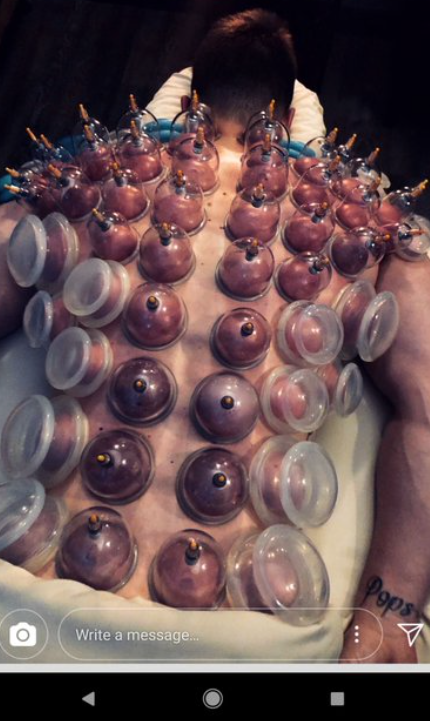
In some precincts of Major League Baseball the placebo effect is alive and well. To that, there can be no dispute, especially given one of the most extreme examples of "cupping" that you are ever likely to see.
Cupping, in case you haven't heard of it, is a Chinese practice that dates back centuries (if not millennia), one which purportedly increases blood flow to injured or sore areas of the body. It uses glass cups and the suction created inside them to pull the skin up, drawing blood to the area and producing purplish welts when the treatment is completed. They are left on the skin for 10 to 15 minutes.
The exterior of the cups are heated to create the effect, while other cups have a suction device that removes the trapped air.
Now while there are those who favor this process, and believe they feel better as a result – the very definition of a placebo – the medical community says there is no evidence that it produces any health benefits.
 Pro sports has its share of so-called cuppers, which includes swimmer Michael Phelps, and his embrace of the practice at the 2016 Summer Olympics in Rio de Janiero (picture via Google Images). Meanwhile, baseball has a significant number of believers, a faction that has been documented over the years.
Pro sports has its share of so-called cuppers, which includes swimmer Michael Phelps, and his embrace of the practice at the 2016 Summer Olympics in Rio de Janiero (picture via Google Images). Meanwhile, baseball has a significant number of believers, a faction that has been documented over the years.
But few have taken cupping to such an extreme as Bryce Harper, the star Washington Nationals outfielder, who posted a photo on Instagram last week of a recent treatment showing cupping over nearly his entire back. As for why Harper decided to go to such extremes, the 25-year-old provided no explanation and little insight. The only words accompanying the graphic picture were "Feeling like bowser!," referencing a Super Mario character.
"I cannot conceive of any benefit except a psychological benefit," said Barrie Cassileth, chief of integrative medicine service at Memorial Sloan Kettering Cancer Center, speaking to the Wall Str eet Journal in 2014. "There's absolutely zero evidence that cupping has any kind of positive role in medicine." Further, studies have failed to find evidence that cupping provides health benefits.
eet Journal in 2014. "There's absolutely zero evidence that cupping has any kind of positive role in medicine." Further, studies have failed to find evidence that cupping provides health benefits.
None of that, however, matters to those athletes attracted to cupping. Some report that their muscles are looser immediately afterwards, and that soreness disappears. And for the limited number of years that they have to play professionally, believing that cupping works for them – even if it has no proven effect – is all that really matters.
"The placebo effect is a lot more powerful than people realize," said Vic Black, a former pitcher and supporter of cupping. "There's more belief in it, and that's why I feel comfortable doing it."
Major League Baseball has no discernable policy on cupping; searches conducted on its website proved fruitless. As for the teams themselves, many don't wish to discuss the topic publicly, meaning they neither endorse or prohibit the therapy, and their silence makes it difficult – if not impossible – to estimate how many players are engaged in the practice.
Harper was named the National League's Most Valuable Player in 2015. Which stands to reason that if one of baseball's biggest stars is publicly promoting its benefits, it's likely cupping will remain a clubhouse placebo-staple for years to come.



